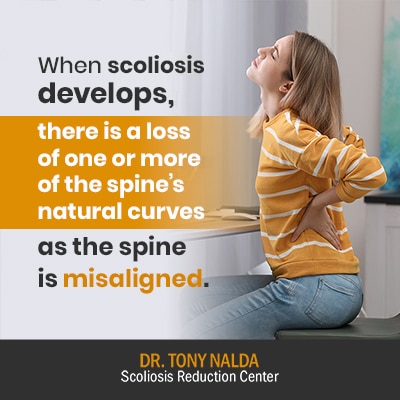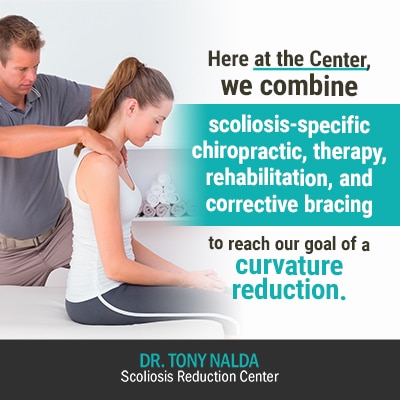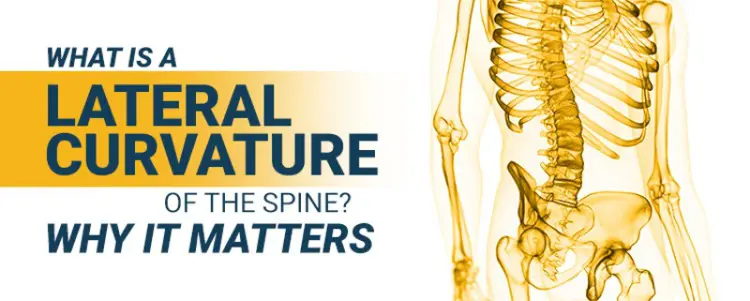As the brain and spinal cord work together to form the body’s central nervous system (CNS), any condition that affects the spine has can impact multiple areas of the body. As a spinal condition, scoliosis has the potential to produce a variety of symptoms and impact how the brain communicates with the rest of the body.
The spine’s natural curvatures make it stronger, more flexible, and better able to absorb and distribute impact incurred through movement. When the spine develops scoliosis, this means there is an abnormal lateral curvature of more than 10 degrees that includes rotation. This matters because it means the spine’s healthy curves are replaced by bad curves.
As we’ve touched on, the spine has healthy curvatures that are characteristic of each main section of the spine. For a better overall understanding of scoliosis and how it impacts the body, let’s start with some basic spinal anatomy, including where the spine’s healthy curvatures are and why they are important.
Basic Spinal Anatomy
Most people are born with 33 vertebral bodies that make up the spine. These are the individual bones of the spine that are stacked on top of one another.
These vertebral bodies are separated by intervertebral discs, which cushion the vertebrae, preventing them from rubbing up against each other. The discs also facilitate movement and act as the spine’s shock absorbers.
It’s also important to be aware of the main sections that make up the spine, especially in the context of scoliosis, as curvature location is a factor in progression and classifying the condition.
Spinal Sections
There are three main sections to the spine: cervical (neck), thoracic (middle/upper back), and lumbar (lower back). Each of these sections has a characteristic curve, and together, when viewed from the side, these curvatures give the spine its soft ‘S’ shape.
These curves work together to give the spine added strength, flexibility, facilitate our upright and straight posture, and to help evenly distribute stress along the spine.
If there is a loss of one of the spine’s healthy curves, this impacts the others and throws off the spine’s overall biomechanics.
Anatomical Planes of the Spine
In the medical community, we refer to sections of the body as anatomical planes; this helps us to accurately communicate the area and parts of the body affected by a condition.
Discussing the anatomical planes of the spine help give a better understanding of the 3-dimensional nature of scoliosis and what is happening when an abnormal lateral curvature develops.
A plane is a 2-dimensional slice through a 3-dimensional space; you can think of this as a glass sheet.
Anatomical planes use lines to divide the body into sections, and these planes can also be used when referencing the spine and conditions that affect it.
There are three main planes to be aware of: sagittal, coronal, and transverse.
Sagittal – the sagittal plane of the spine is a vertical line that divides the spine into its left and right section.
Coronal – the coronal plane of the spine is a vertical line that separates the spine’s front (anterior) section from its back (posterior) section.
Transverse – the spine’s transverse plane divides its upper (superior) section from its lower (inferior) section.
Now that you can see how these anatomical planes divide the body into sections and apply to the spine, you might be wondering which planes are impacted by an abnormal lateral curvature, and this is determined by the occurrence of the spine’s natural curves.
Location of the Spine’s Natural Curvatures
As mentioned, each spinal section has a corresponding natural curvature. In addition, the type of curvature, as in those that curve inwards towards the body’s center, or outwards away from it, also have different names.
‘Lordosis’ refers to the natural inward curvatures of the spine, and this curvature type characterizes the cervical and lumbar spinal sections.
‘Kyphosis’ refers to the natural outward curvature of the spine, specifically at the thoracic section.
The spine’s natural curves occur at the cervical, thoracic, and lumbar regions of the spine in the sagittal plane.

When scoliosis develops, there is a loss of one or more of the spine’s natural curves as the spine is misaligned.
As scoliosis is a lateral curvature, meaning occurs from side to side, it’s often described as occurring in the coronal (frontal) plane, but while the degree of curvature (Cobb angle) is measured on the coronal plane, as a 3-dimensional condition, scoliosis is more complex and engages the coronal, sagittal, and transverse planes.
This is because in order for an abnormal spinal curvature to be classified as a true scoliosis, the degree of curvature has to measure at 10+ degrees, but it also has to include rotation, meaning that sideways bend to the spine is accompanied by a rotational component (twist).
Let’s now talk about Cobb angle and rotation: the characteristics that define scoliosis.
Cobb Angle
So we know that for a person’s abnormal spinal curvature to be considered scoliosis, it needs to have a Cobb angle of more than 10 degrees, but what exactly is a Cobb angle?
Cobb angle is known as the orthopedic gold standard for assessing scoliosis. It’s a measurement obtained via X-ray by drawing intersecting lines from the tops and bottoms of the most-tilted vertebrae of the curvature. The resulting angle reflects how far out of alignment a scoliotic spine is.
A patient’s Cobb angle is not only an important variable in the diagnosis of scoliosis; it also further classifies the condition by placing it on its severity scale of mild, moderate, or severe.
- Mild scoliosis: Cobb angle measurement between 10 and 25 degrees
- Moderate scoliosis: Cobb angle measurement between 25 and 40 degrees
- Severe scoliosis: Cobb angle measurement of 40+ degrees
Now, if a patient has a Cobb angle measurement of 10+ degrees and includes rotation, this is considered structural scoliosis, meaning the curvature is not temporary and/or related to another issue.
This leads us into the difference between structural and functional scoliosis.
Structural vs. Functional Scoliosis
To explain it simply, the big difference between structural and functional scoliosis is that people with structural scoliosis have spines with an abnormal structural physical curve; people with functional scoliosis have spines that ‘appear’ to be curved.
In functional scoliosis, the curvature can be temporarily caused by chronic bad posture, or some form of irregularity elsewhere in the body, such as different leg lengths. As the body will adjust itself to try and maintain balance and symmetry, if the legs are different lengths, a spinal curvature can develop in an effort to compensate for the asymmetry caused by the different leg lengths.
When it’s postural, a person can actually straighten up with active effort. They can elongate the spine, pull the shoulders back, and the curvature is lessened or removed; this is because there is no rotational component and the curvature is not structural.
So while a person can have an abnormal lateral curvature of the spine, it’s not considered structural scoliosis if there is no physical change to the structure of the spine, which includes rotation.
Basically, the easiest way to tell the difference is to have the person bend forward or lie down; if it’s non-structural, the curvature will likely go away while being held in that position.
Now that we know some basic spinal anatomy, including the role and location of the spine’s natural curves, and what it means to develop scoliosis, let’s move on to why having scoliosis can matter to the rest of the body.
How Scoliosis is Expressed Throughout the Body
Obviously, we know that as a spinal disorder, scoliosis is going to produce changes in the spine, but these changes can be felt in multiple areas of the body.
The reason it’s so important to engage in active treatment for scoliosis is because it’s a progressive and incurable condition; this means that it’s in its nature to get worse over time.
While we can’t cure scoliosis, we can most certainly treat it and manage it effectively, and this means staying ahead of the condtition’s progressive line.
As scoliosis progresses, this means the abnormal spinal curvature is getting larger and more severe. As a condition gets more severe, it’s more likely to start producing noticeable symptoms such as pain (adult scoliosis) and postural changes.
Postural Changes
Part of the reason scoliosis is often described as a complex condition is because it can range so much in severity and expressed symptoms.
While there are certain symptoms that are associated with certain forms and severity levels, each and every patient will have their own unique experience of their condition and the symptoms it produces.
What one person with a 25-degree thoracic curve experiences is not necessarily indicative of what another person with the same curvature size and location will experience.
The milder a condition is, the less likely it is to produce symptoms that anyone other than a scoliosis specialist might be able to spot, which is why early detection is not always easy.
That being said, following are some common postural changes associated with scoliosis, and these are the signs to watch out for in yourself or a loved one:
- Uneven shoulders
- One shoulder blade protruding more on one side than the other
- One side of the hip appearing flatter or more rounded than the other
- Rib arch
- Arms and legs that seem to hang at different lengths
- Head that appears uncentered over the torso
- Torso appears uncentered over the waist
- Uneven waistline
These symptoms develop as scoliosis affects the body’s symmetry. Often, it’s an overall asymmetrical appearance of the body that makes people realize there is something wrong. Changes to gait and issues with balance can also be a sign that something is amiss.
As mentioned earlier, these signs and symptoms can range significantly, with some being too subtle to notice, and others being overt and easily detectable.
Here at the Scoliosis Reduction Center®, I have treated all forms and severity levels of scoliosis, so I can easily spot an indicator for the condition, even in the milder stages of progression.
That being said, our ultimate treatment goal is to reduce a patient’s curvature so we are impacting it on a structural level, and this would also address any rib deformity present at the same time.
By doing this and working to sustain those results, we are managing to stay ahead of the condition’s progressive line, thereby helping our patients to avoid the hardships associated with more severe stages of progression.
This is especially the case in severe scoliosis, as once a person’s degree of curvature reaches that surgical threshold (40+ degrees) and progression doesn’t appear to be slowing, those following the traditional treatment approach are funneled towards spinal-fusion surgery.
Here at the Center, surgery is not an option. I believe in a functional alternative approach to scoliosis treatment that keeps patients off the operating table.
So as we’ve addressed why having an abnormal lateral curvature of the spine matters for the body, let’s discuss what to do about it.
Treating Scoliosis
I’ve said it before, and I’ll say it again: even though we can’t cure scoliosis, and in its most common from (AIS), we don’t fully understand its etiology, we most certainly know how to treat it.
At the point of receiving a scoliosis diagnosis, there is a big decision to be made, one that can have life-long consequences, and that is how to move forward with the condition and treat it.
I mentioned that the traditional approach funnels people towards spinal-fusion surgery, which is something I don’t support.
I believe that spinal fusion should only be used as a last resort after all other treatment methods have been attempted unsuccessfully.
My approach here at the Center is natural, non-invasive, and functional. We don’t just want to address the condition’s symptoms, but the condition itself, which means impacting it on a structural level by achieving a curvature reduction.
We do this by integrating multiple treatment disciplines so we can fully customize our treatment plans to address the individual characteristics of each patient and their condition.
Once scoliosis develops and there is a loss of the spine’s healthy curves, the body responds by putting in bad curves, and this can result in postural changes, pain (adult scoliosis), sleep problems, headaches, and in severe cases that are left untreated, additional complications such as digestive issues and lung impairment.
Conditions that affect the spine can also affect the brain as they work together, forming the body’s central nervous system, and facilitating communication between the brain and the rest of the body.

Here at the Center, we combine scoliosis-specific chiropractic, therapy, rehabilitation, and corrective bracing to reach our goal of a curvature reduction. By doing this, we are addressing the condition’s underlying structural nature and staying ahead of its progressive line.
Our approach is about correction and prevention as we work towards actually changing the structure of the spine, reducing the curvature, and preventing it from progressing to more severe levels.
By reducing a curvature, we are not just impacting the condition structurally and helping prevent further progression, we are also addressing the underlying cause of any experienced symptoms, which are also lessened and/or eliminated as the spine’s healthy curves are restored.
Conclusion
While the body can do remarkably well at adjusting to structural changes, when scoliosis is left untreated and the abnormal lateral curvature is left to progress unimpeded, complications can arise.
As a condition progresses, the spine’s unhealthy curvature gets larger, and as this happens, the condition is more likely to produce adverse symptoms such as noticeable postural changes.
For those who choose the traditional-treatment path, a condition progressing and reaching the ‘severe’ stage also means the likely recommendation for spinal-fusion surgery; this is a costly and invasive procedure with some heavy side effects and risk of complications that should be avoided.
Here at the Scoliosis Reduction Center®, we are proactive, instead of reactive. We don’t just monitor our patients and respond once their condition reaches a certain level, as the traditional approach would; we respond immediately by starting active treatment as close to the time of diagnosis as possible.
We don’t want to waste valuable treatment time, and as our ultimate goal is to help our patients avoid the hardships of reaching the later stages of progression, starting a customized treatment plan early can have a big impact on treatment efficacy.
So what is a lateral curvature of the spine, and why does it matter? An abnormal lateral curvature of the spine, diagnosed as scoliosis, means the spine’s health and function are at risk, along with the likelihood of developing scoliosis-related symptoms such as postural changes, headaches, and pain (in adults).
This matters because as a progressive condition, if left untreated and not addressed proactively, it’s bound to get worse over time, along with the effects it can have on the rest of the body.
Fortunately, with a functional treatment approach, scoliosis can be managed effectively so that patients can move forward with their condition as positively as possible.





